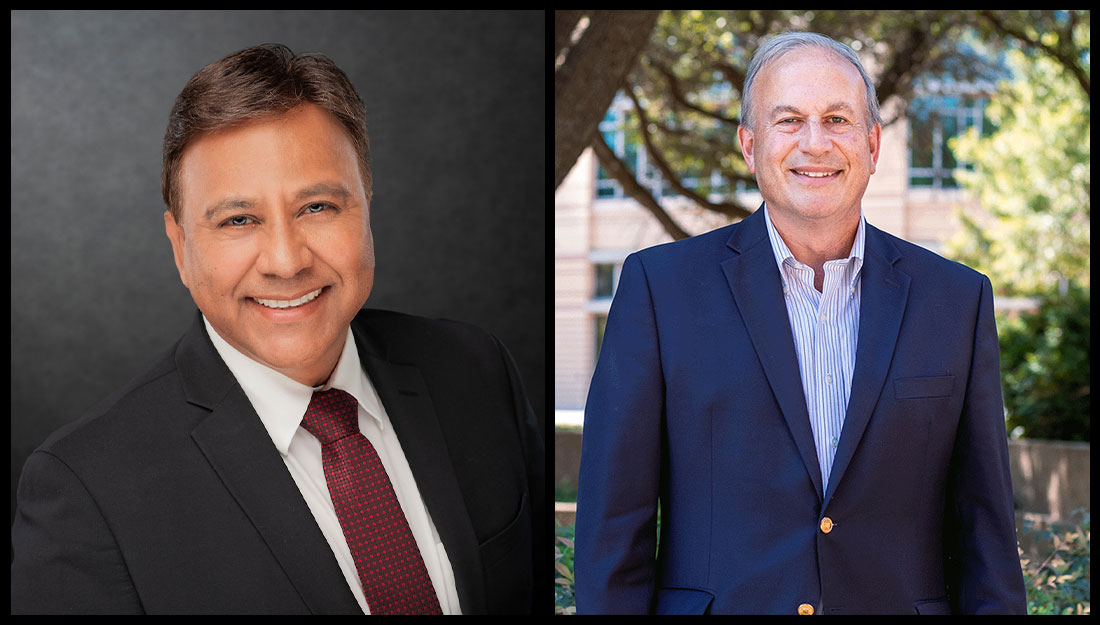- Lindsey Hendrix
- Community, Medicine, Show on VR homepage
A life of service and adventure leads former Naval officer to a career in military medicine
From Navy special ops to conquering Mount Everest, Pat Monday has always chased a challenge. His next endeavor: Naval physician
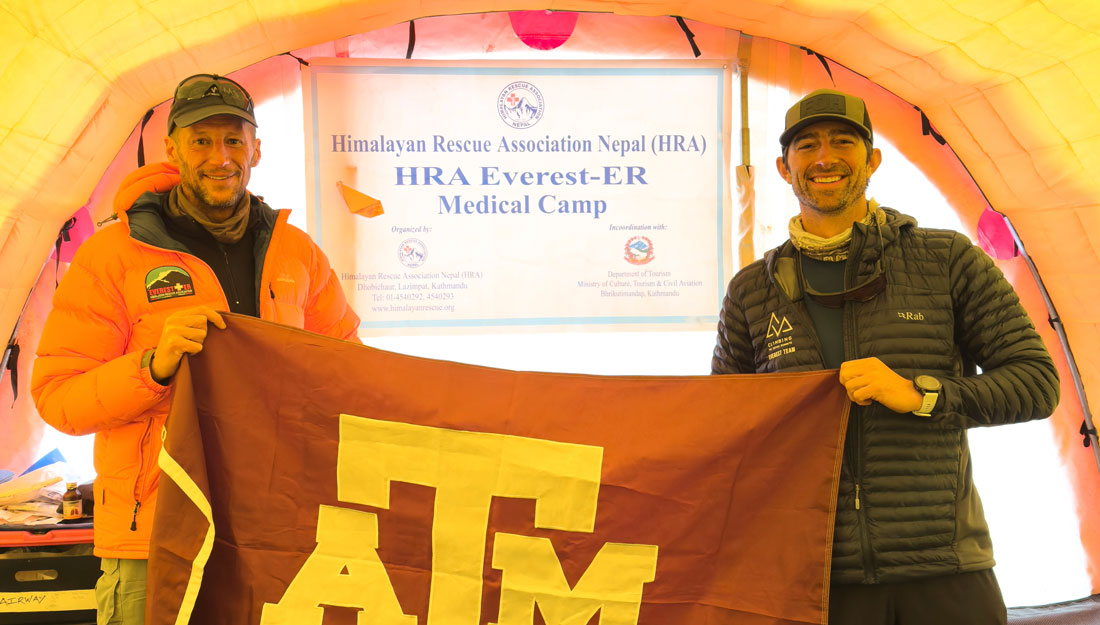
First-year medical student at Texas A&M College of Medicine, Pat Monday (right), holds the Texas A&M flag with Col. Gregory Stiller, MD, 153rd Air Surgeon, Wyoming Air National Guard, who serves as the lead physician at the Everest Base Camp emergency room in Nepal. (Contributed photo)
When Patrick Monday ’22 ’28 first learned about Earth’s tallest mountain as a boy in third grade, he wanted to climb it.
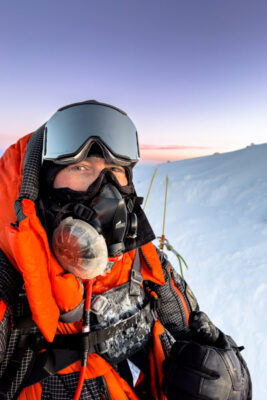
“Like a lot of little kids, I thought, wow, I want to climb that—the tallest mountain on Earth. Who didn’t think that as a kid?” he said.
Except, unlike most people, this kid from northern Utah grew up and did it.
On May 13, 2024, Monday became one of only two Texas Aggies to ever scale the highest mountain peak above sea level. And at 29,032 feet, he was up higher than any other living thing on the planet that day.
“It’s a bit dramatic to say, but in many ways, the summit of Everest has a lot more in common with near-space than it has with sea level. Humans just aren’t built to be up there. But we were there,” he said, recounting the early morning he and his climbing partner were the first people of the day to reach Everest’s summit. “It’s pretty amazing what we’re able to achieve in these extreme environments through physical training and engineering innovations.”
Chasing a challenge
Climbing Mount Everest was just one of many challenges Monday has put himself against. As a high school athlete, he played multiple sports that demanded mental and physical strength and agility. He went on to throw javelin for the Utah State University track and field team, walked onto the university’s football team his freshman year, and worked as a volunteer firefighter and emergency medical technician (EMT) while he attended school. But all the while, there was another challenge he couldn’t wait to take on.
“All throughout my time at Utah State I wanted to go into the military. 9/11 happened my freshman year of high school, so there was this desire to go and respond to that,” he said. “I was an athlete, so I wanted to do something physically and mentally challenging that could put myself in a position in the military where I could be best used to serve our country in that capacity.”
After graduating from Utah State in 2010 with a bachelor’s degree in history, Monday joined the Navy, where he served aboard the USS Tortuga before commissioning with the Explosive Ordnance Disposal (EOD) team. As an EOD officer, Monday was in his element.
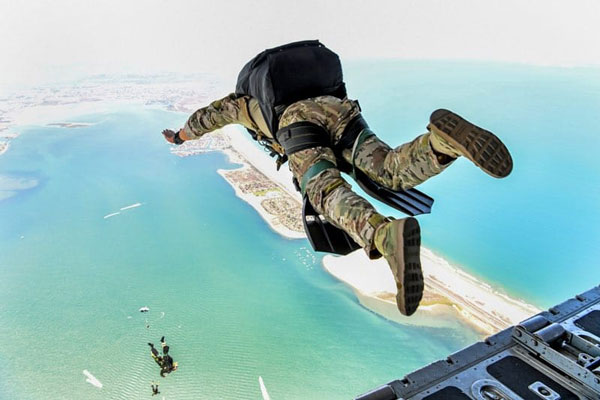
EOD teams are responsible for neutralizing explosive weapons both on land and underwater in sometimes extreme conditions. They’re trained to run and swim long distances, parachute out of planes, dive into oceans, proficiently use small firearms, safely disarm explosives and protect against chemical, biological, radiological and nuclear weapons. As special operations Sailors, EOD teams are often called upon to support other military units and offices, such as the SEALs and the U.S. Secret Service.
Monday’s most memorable assignment was as the officer in charge of a short attachment in New Jersey. Their job was to serve as a stateside response team to any military ordnance—such as ammunition, weapons and machinery—found throughout the tri-state area.
“People dig up stuff in their backyards and turns out they’ve got an explosive from more than a hundred years ago—Civil War, even Revolutionary War era devices,” Monday said. In these cases, EOD would be called in to inspect and neutralize the items.
His team also partnered with law enforcement agencies to augment their capabilities. This included serving as the dive team for the Secret Service in New York City and supporting the FBI. The assignment fit right into Monday’s vision of protecting his nation from an attack like 9/11.
“That was, I think, honestly, the most rewarding tour of my career. Unlike the tours overseas, we were home, and we got to see the direct impact of what we do in every day American life,” he said.
From munitions to medicine
His role as an EOD officer not only fulfilled Monday’s drive for a physical and mental challenge, it also aligned with his desire to save and protect human life.
“When choosing to do EOD, there was very much a kind of first responder mindset,” he said. “We’ve actually had a number of guys who have transitioned from EOD to medicine. I think it ties into applying a lot of critical thinking and scientific principles to approach a problem to saves someone’s life. When I was training to work on a hostage device, I had to take into account all of the variables—quickly—before making a life-altering decision. Trying to apply a cookie-cutter solution set to a problem generally doesn’t work out so well. It’s the same thing with medicine, where we’re going to apply critical thinking to our patients’ unique situation and walk through this problem together and get you better.”
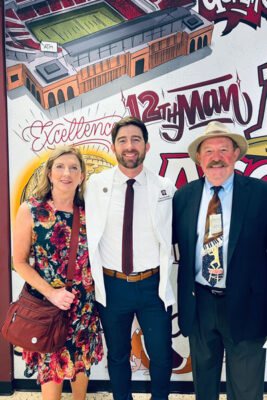
After serving in active duty for 13 years, Monday says going into medicine feels like the next right move for him. He’s now in the Navy Reserves and his first year of medical school at Texas A&M, which is where he fulfilled his final active-duty station as a NROTC instructor. He also earned his second bachelor’s degree, in biology, from Texas A&M while stationed there.
He said choosing to stay for his medical degree was easy.
“As far as I’m aware, the Texas A&M College of Medicine is the only civilian medical school with a military medicine program, which is super awesome. And when I was at A&M as an ROTC instructor and student, I got to see how veteran friendly and involved it is with its military personnel—those who are going in and those who have been in,” he said.
Monday said Col. Jim Lucas, MD, FACS ’92, US Army (Ret.), director of the Military Medicine Program at Texas A&M, has been very supportive of his research interests and the specific aspects of military medicine he wants to pursue.
“There’s a lot of forward progress in what we’re doing here at A&M Medicine that is opening doors in new ways. These are exciting times and there’s a lot of room for innovation and adaptation. If I have an unconventional idea, it’s been well received, and it feels like the program can adapt to it. I appreciate that receptiveness to ideas because that’s how we continue improving medicine,” he said.
After he completes his medical training, Monday plans to redesignate to the Navy Medical Corps as a military physician.
Fortuitous timing
In September 2024, Monday cycled LoToJa, the nation’s longest one-day bicycle race sanctioned by USA Cycling. It covers more than 200 miles that includes three mountain passes from Logan, Utah, to Jackson Hole Mountain Resort in Wyoming. Monday used the event to raise awareness and funding for the Navy Special Operations Foundation and the HunterSeven Foundation, a veteran-founded nonprofit specializing in medical research and education on toxic exposures and subsequent illnesses, such as cancer, specifically for post-9/11 veterans.
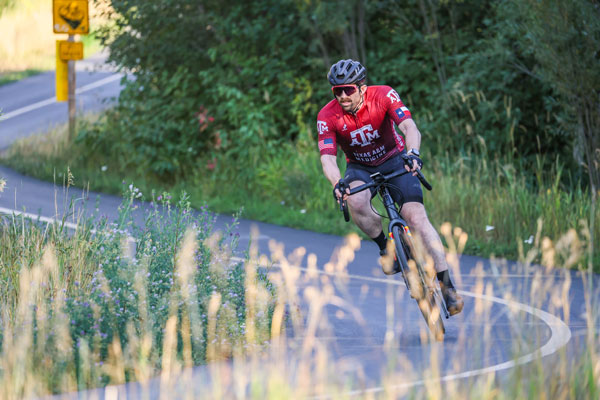
On the day of the race, shortly after passing the 10-mile mark, Monday rode upon an accident between two cyclists ahead of him. With no medical crews in sight, he stopped to render aid. One of the cyclists appeared to have broken her wrist, so he drew from his experience as an EMT to quickly craft a splint made of a piece of wood he found nearby and a spare bike tire tube to stabilize the injury.
“I made probably the world’s jankiest splint, but that’s what I had there to work with,” Monday said, laughing. “We had a couple of support cars that rolled up but no one with medical training. So, I feel better about being where I was to be able to help her and help navigate people around us in what we needed.”
After the 45-minute delay, Monday missed the cutoff time 81 miles down the road by only two minutes.
“It was kind of a bummer that that was the disqualifier, and I was so close to the time,” he said. “But they let me go ride up with my support crew and then do the last leg just for fun, because that’s the epic part of the race—the 25-mile finisher into Jackson, which is gorgeous.”
The LoToJa accident wasn’t the first time Monday was the only person nearby able to medically assist someone in need. During a flight to Austin, he responded to the classic overhead page asking if any doctors, nurses or other medically trained individuals were on board. The person in need was a young man who appeared to be unconscious in the back of the plane—and he was holding a military ID. The other incident happened in a bicycle shop in College Station when a young man had a seizure. In both cases, Monday was able to help the young men back to consciousness and safety.
Respect
What pushes Monday, the athlete, mountain climber, long-distance cyclist, former special ops officer, future Aggie doctor—oh, and private pilot—to the extreme?
“My family has always been there to support me. I would not be here were it not for their steadfast support—even if they’re not always super enthusiastic about the choices I make,” he said with a laugh. “I enjoy situations that challenge how we think, where the consequences are high. It forces you to stay on your toes and own your decisions. But really the biggest reward of doing these activities is that they have led me to travel and interact with people all over the world, in varying walks of life. These experiences, these encounters, have helped me grow to understand more and more human perspectives, which is incredibly important as a future physician.”
And when it comes to serving others, he says the Aggie Core Value of Respect drives him toward his next chapter.
“I think where I am with what I’m doing in medicine and moving forward into a career in medicine, respect is the core value that means the most to me,” he said. “Everybody’s a human being. We’re imperfect creatures, we can reach the highest highs, the lowest lows, and everything in between. At the end of it all, respect is what gives us that compassion for human life and continuing to improve it.”
Media contact: media@tamu.edu

